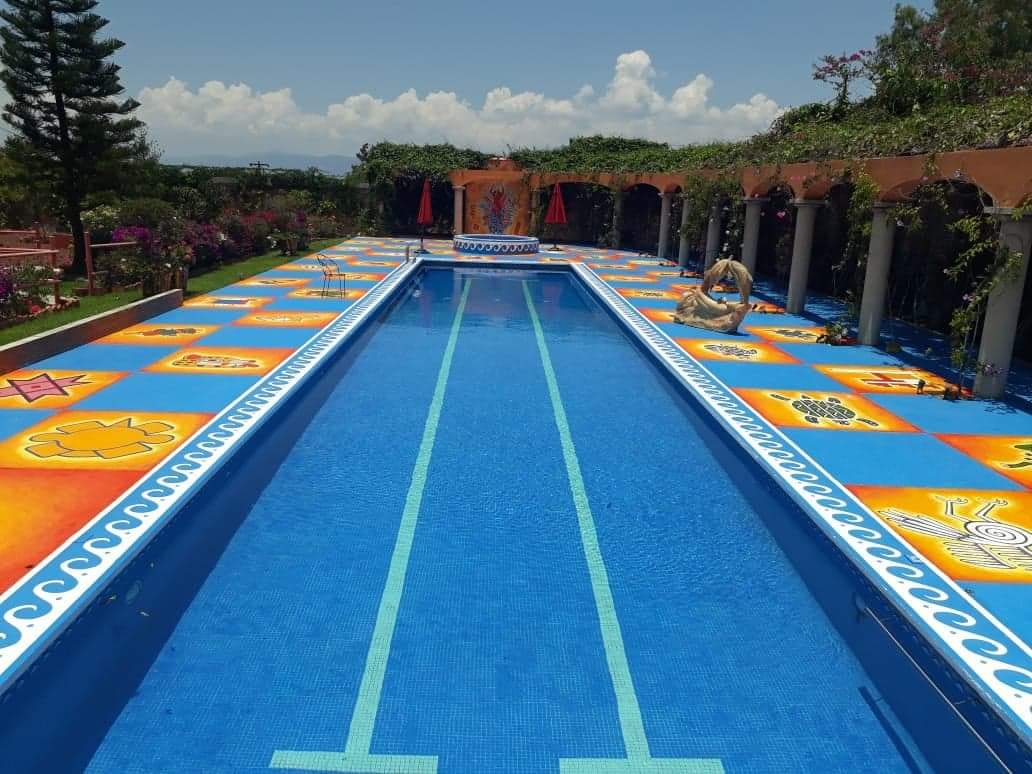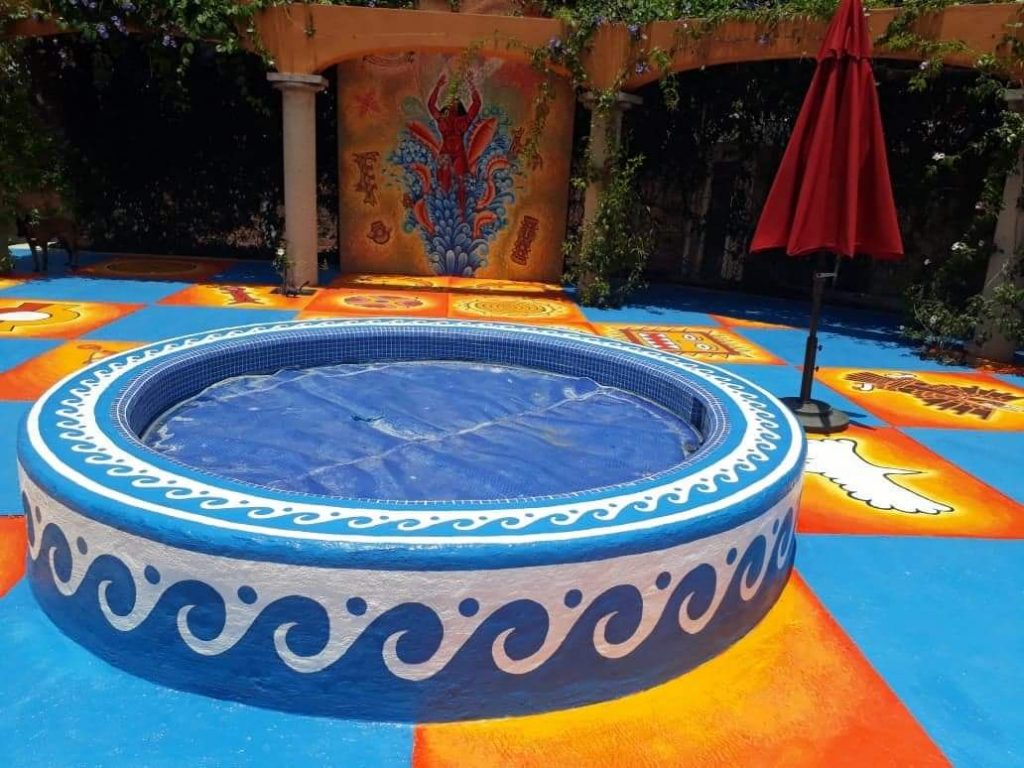Mystic Muralism on the Shores of Lake Chapala


Mexican art is often defined by the use of vivid colors and bold mythical figures representing both pagan and Christian themes. Muralist painter, Jesus Lopez Vega, captures those contradictions in his bold works that among other things, pay homage to the natural waters of Mexico’s Lake Chapala, the largest in Mexico, an object of both concern and admiration.
By Eric Herman
This past September, my wife, Diane, and I had the pleasure of visiting the town of Ajijic in Jalisco, Mexico, on the shores of Lake Chapala, where the locals claim the area has the world’s best weather. A massive settlement of mostly American, Canadian and European expats, the area is, among many other attributes, home to a vibrant art scene.
During our trip, we were introduced to local mural artist, Jesus Lopez Vega. The initial reason for the meeting was that he had painted a deck and surrounding walls by a swimming pool. Our friends and hosts, Merry and Charles Wise, both retired pool-industry professionals, thought Lopez Vega’s work might make for an interesting WaterShapes article.
We paid a visit to the artist’s studio, where Lopez Vega regaled us with his unique passion, artistic perspective, and personal history. It was a fascinating conversation that quickly reached far beyond painting murals on swimming pool decks.
SETTING THE SCENE
A native of Ajijic, Lopez Vega was largely educated in the U.S., spending his teens in southern California, and young adult years in Portland, OR. Now a fulltime resident in his hometown, his studio includes a small shop on the street front, and an art gallery featuring his work and that of his brother, Antonio Lopez Vega. In the back behind the gallery, his working area is overflowing with art supplies, accoutrements, sketches and works in progress.
Through his often mystical and highly representational works, Lopez Vega channels the visions of the ancients, the energy of Mexico’s native traditions, the schemes of its political reformers, and his complex psychological experience. The brilliant colors and shapes of his art weave often complex visual tapestries of both joy and sorrow.
Lopez Vega credits his childhood immersion in art as the reason he has found a high-level of artistic success today. His journey began with a woman named Neill James, a local legend on the shores of Lake Chapala. “I was so fortunate to find myself at the Neill James’ children’s art program each Saturday,” he says. “There, I learned technique and was given confidence.”
That is why he can often be found teaching at the ongoing Children’s Art Program at the Lake Chapala Society in Ajijic, founded by James. One of Ajijic’s original expatriates, James was a woman who would synthesize her vast personal experiences with a powerful vision of the future, as expressed through children’s art education.
A WORLD VISION
As Lopez Vega explained, Neill James was an experienced world traveler, who left her mark on the community in many different ways. She opened the first libraries for the children in the area and she also taught cooking classes to local Mexican women. Among her many accomplishments, James developed a water-purification system and helped install both electricity and the telephone services. She discovered gold in the caves in the mountains above Ajijic, and most notably, she set up a school for the local children’s education, especially in the arts.
The Lake Chapala Society (LCS) was founded in 1955 as a cultural, social and benevolent society by James and a group of 21 adventurous expats living in Ajijic. Later, Neill bequeathed her village home to the LCS agreeing to leave the sprawling property to the community, so long as she could live there until her death. Neill died in 1994, just a few months shy of her 100th birthday.
Today the LCS has grown to approximately 4,000 members comprised mostly of local expatriates. Lopez Vega, who was one of the program’s great success stories, remains devoted to the greater purpose James defined decades ago. Having lived and studied in the U.S. for many years, he is now back in his hometown where he carries on the tradition of art education.
Here are some excerpts from my discussion with Jesus Lopez Vega.
How important was Neill James’ influence on you, as a person and an artist?
She was a great influence. She created a place where children grow and learn how to make art. The kids go to the children’s program from four to 14 years old. The ones that continue painting are the real artists.
The truly talented kids are the ones that she helped to develop their formal art education. That’s what we are interested in today and into the future, inspiring and training them to become true artists. That is why Ajijic has become an artistic colony; we have a way to identify, inspire and develop talent. That’s what happened to me.
What made her so inspirational?
She was able to inspire so many people, because she was a world traveler and she knew how to communicate her vision. She was in Asia, Europe and other parts of the world, and then she came to Mexico where she shared her experiences and what she learned, which had a great influence on people in this community.
Her philosophy grew because she lived with Muni Indians, for example, and other indigenous tribes, and because she studied in Japan. So, from those experiences she learned how to cultivate the earth, she learned about the silkworm, and our connection to nature and water.
She was also part of an awakening in Mexico that had been going on for a long time, really ever since the Mexican Revolution. There was a growth in Mexico, a flourishment. With all the intellectual people, they were putting the education forward, to all of Mexico, to different villages not just the cities. That was a revolution in public education. That movement was led by Jose Vasconcelos, a Mexican philosopher and a Prime Minister of Education.
Vasconcelos studied the aesthetic of the pre-Columbian: the figures, archaeology, and arts. And, through that, he started a Mexican art school, not depending from Spain anymoreNeill James was there at that time, and she became involved with all the muralism. That was in Mexico City in the time of Diego Rivera, José Clemente Orozco, Siqueiros, all the great muralists.
She became influenced by the Mexican public education and art, and that’s how she brought this idea to Lake Chapala.
How is your art influenced by your cultural roots?
The Mexican culture comes from two sources: one shoulder is very heavy in Catholicism, and the other shoulder, we have the pre-Columbian world.
The Mexican race is just 500 years old. It’s not like the Chinese or the Jewish cultures, which have existed for thousands of years. We are a new race. So, we still have on our shoulders the pre-Columbian and the Spanish. And we are in conflict because as a people we haven’t decided yet which side we go to. Sometimes those two things are in the same person.
Is that conflict present in your works?
Yes, my art is syncretism. I have the two sides, the two traditions. I believe that Mexican art becomes very powerful and colorful by combining that duality. Everything is a dichotomy. It’s defined by the two conflicting halves.
There is the Catholicism. This is like the crusades that moors against the Spanish or Roman Catholic, Christians. crusades, and the modern crusade, which in my opinion is why we have problems. Not only religion, we have more serious problems, which is what we’re doing to nature.
The pre-Columbian world is in contrast with its appreciation of nature and feeling of connection to it.

Mexican people see both sides, and I do feel connected to those traditions. And, the art is special because of it.
Do you like putting your work next to water?
Yeah, as long as I find the right materials (laughs), the very good materials. Yes, where I did that mural there, the client was interested in doing something different. I showed him a past project. He asked can you paint it around the pool? I said, yes, but I don’t want it to fade.
I found a very toxic paint used for roads. Not only is there the yellow and the white we see all the time, but they have all these other colors. So, it’s very, very, durable with all of the colors I needed. But, it’s not easy, I had to wear a mask because it’s very toxic. But in the end, it looks beautiful and helps create a very artistic and meaningful environment, that’s also very colorful. Water is very important to our cultur; Lake Chapala is sacred, and it’s also badly polluted. I believe we’re destroying our natural world and, along with it, a very important part of ourselves. That’s why water is a very important subject in my work, whether it’s around a pool, or not.












